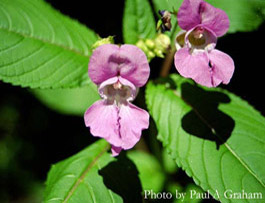Policeman's Helmet
| Description: |
Policeman’s helmet is a succulent, smooth and hairless annual that ranges in height from 3 to 10 feet tall. The upright stems are hollow and have a purplish tinge. Its serrated leaves are oval to egg shaped and about 6 inches long and 3 inches wide. Flowers are white, pink or purple and resemble an old-fashioned English policeman’s helmet. The fruit is a five chambered capsule capable of producing 800 seeds each. |
||||
| Why Is it a Noxious Plant? |
It is a highly invasive, aggressive invader of wetlands, streams and moist woodlands. It displaces native plants and contributes to flooding and erosion by changing or stopping water movement. |
||||
| Where Does it Grow? |
It is considered extremely invasive to moist, natural areas. Introduced and sold as an ornamental, this species has escaped, with distribution primarily in lowland riparian areas, which include moist forests, stream sides and roadside thickets. Policeman’s helmet is tolerant of many soil types, but requires high moisture content. It thrives in partial shade, but will also grow in full sun. |
||||
| Facts: |
When touched, the mature seed pods split and eject seeds up to 20 feet. |
||||
| Control Options: |
Policeman's helmet has a shallow root system, making hand pulling very easy. Small infestations can be effectively hand-pulled or dug up. Isolated plant should be carefully removed in order to stop them from infesting a larger area.
|
||||
| More Information: |
Download our Flyer or visit Washington State Noxious Weed Control Board Here. Photo by Leo Michels
|
||||
| More Pictures: |
|







 Pierce County Noxious Weed Control Board • 9200 122nd St E, Puyallup, WA 98373 • 253-798-7263
Pierce County Noxious Weed Control Board • 9200 122nd St E, Puyallup, WA 98373 • 253-798-7263